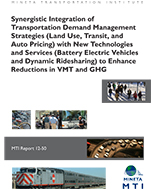- 408-924-7560
- mineta-institute@sjsu.edu
- Donate
Synergistic Integration of Transportation Demand Management Strategies (Land Use, Transit, and Auto Pricing) with New Technologies and Services (Battery Electric Vehicles and Dynamic Ridesharing) to Enhance Reductions in VMT and GHG
It is widely recognized that new vehicle and fuel technology is necessary, but not sufficient, to meet deep greenhouse gas (GHG) reductions goals for both the U.S. and the state of California. Demand management strategies (such as land use, transit, and auto pricing) are also needed to reduce passenger vehicle miles traveled (VMT) and related GHG emissions. In this study, the authors explore how demand management strategies may be combined with new vehicle technology (battery electric vehicles or BEVs) and services (dynamic ridesharing) to enhance VMT and GHG reductions. Owning a BEV or using a dynamic ridesharing service may be more feasible when distances to destinations are made shorter and alternative modes of travel are provided by demand management strategies. To examine potential markets, we use the San Francisco Bay Area activity based travel demand model to simulate business-as-usual, transit oriented development, and auto pricing policies with and without high, medium, and low dynamic ridesharing participation rates and BEV daily driving distance ranges.
The results of this study suggest that dynamic ridesharing has the potential to significantly reduce VMT and related GHG emissions, which may be greater than land use and transit policies typically included in Sustainable Community Strategies (under California Senate Bill 375), if travelers are willing pay with both time and money to use the dynamic ridesharing system. However, in general, large synergistic effects between ridesharing and transit oriented development or auto pricing policies were not found in this study. The results of the BEV simulations suggest that TODs may increase the market for BEVs by less than 1% in the Bay Area and that auto pricing policies may increase the market by as much as 7%. However, it is possible that larger changes are possible over time in faster growing regions where development is currently at low density levels (for example, the Central Valley in California). The VMT Fee scenarios show larger increases in the potential market for BEV (as much as 7%). Future research should explore the factors associated with higher dynamic ridesharing and BEV use including individual attributes, characteristics of tours and trips, and time and cost benefits. In addition, the travel effects of dynamic ridesharing systems should be simulated explicitly, including auto ownership, mode choice, destination, and extra VMT to pick up a passenger.
CAROLINE RODIER, PhD
Dr. Caroline Rodier is a research associate at the Mineta Transportation Institute and the associate director of the Urban Land Use and Transportation Center and a research scientist at the Institute of Transportation Studies, University of California, Davis. Her major areas of research include transport, land use, and environmental planning and policy analysis. Dr. Rodier has extensive experience applying land use and transport models to inform public investment, planning, and policy decisions. She has managed the development activity-based microsimulation travel models for the State of California and the San Joaquin Valley as well as the California’s PECAS land use model. Dr. Rodier has expertise in the design and implementation of research projects that routinely make use of expert and stakeholder interviews, focus groups, and travel behavior surveys. This research has been conducted in a variety of contexts including parking information and pricing technologies pilot projects (most recently SFpark); shared-use modes to facilitate first- and last-mile access to transit; travel needs and mobility solutions for diverse populations in California (e.g., elderly and immigrants); traffic safety impacts of Variable Message Signs; and the scoping plan for California’s landmark climate change legislation, Assembly Bill 32. Dr. Rodier has also conducted reviews of legal and institutional challenges in the areas of automated speed enforcement, low-speed modes (e.g., Segways and neighborhood electric vehicles), and the provision of public parking for carsharing services. Most recently, Dr. Rodier led the development of the content for scenario activities used in the workshop on Automated Vehicles within the Built Environment: 2020, 2035, and 2050 at the Automated Vehicle Symposium 2014 and 2015. She currently serves at the chair of the Transportation Research Board’s Emerging and Innovative Public Transport and Technologies Committee. She holds a B.A. in US History from Barnard College at Columbia University and an M.S. in Community Development, and a PhD in Ecology from the University of California, Davis.
FARZAD ALEMI
Farzad Alemi is a third-year PhD student at the University of California, Davis, Institute of Transportation Studies (ITS). He is interested in various transportation and land-use related topics, particularly travel demand modeling, land-use modeling, travel behavior, traffic engineering, and sustainable transportation. Prior to coming to UC Davis, he completed his MSc in Urban and Regional Planning (University of Greenwich, 2009- 2010). Before that, he received his BSc in Civil and Environmental Engineering from Iran University of Science and Technology (2009). He is currently working on research projects to quantify/explore the effects of new technology-enabled transportation alternatives on future mobility.
DYLAN SMITH
Dylan Smith is a software developer based in the San Francisco Bay Area. He is a recent graduate from the University of California, Davis. Holding a bachelor’s degree in computer science, he is primarily interested in computer science and its applications in transportation engineering. During his undergraduate career, he worked at the Institute of Transportation Studies (2014-2015) and in an on-campus civil engineering research position (2013-2015), where he developed software to help explore the feasibility of ride-sharing in the Bay Area and the interactions between dynamically-routed vehicles and traffic lights. He is currently helping to found a transportation-focused startup in the Bay Area.
-
Contact Us
San José State University One Washington Square, San Jose, CA 95192 Phone: 408-924-7560 Email: mineta-institute@sjsu.edu






